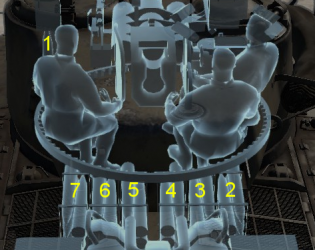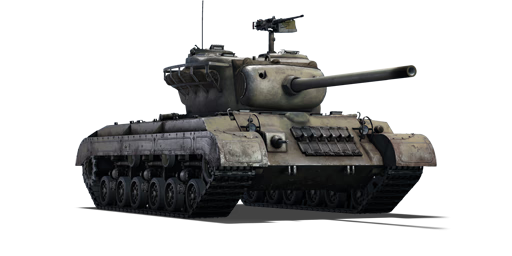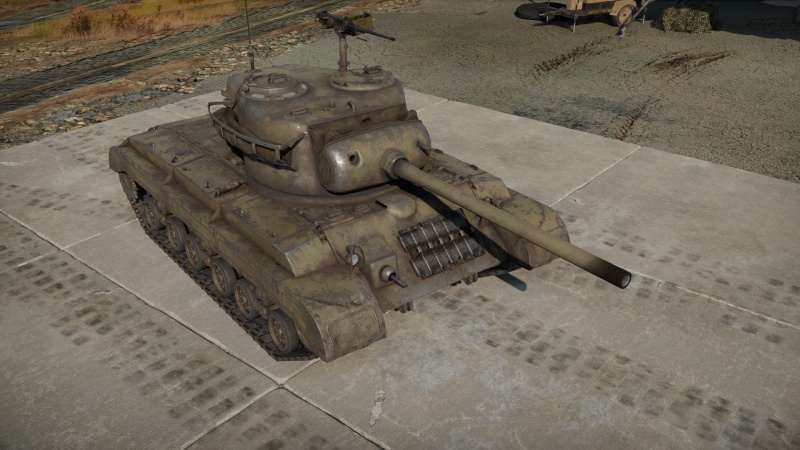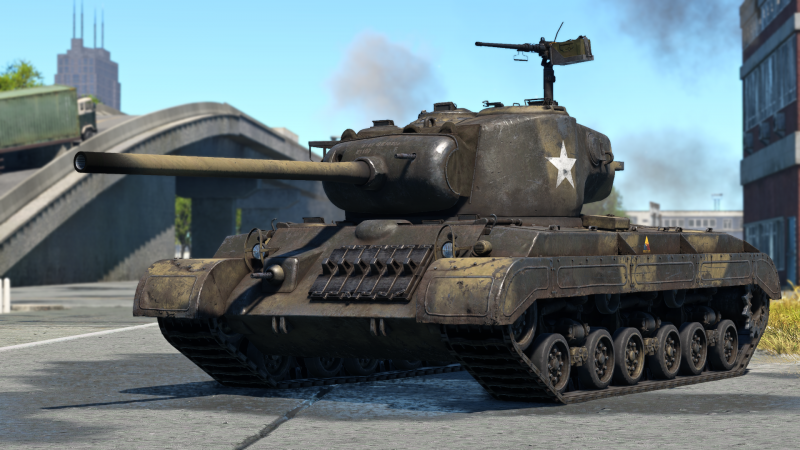Difference between revisions of "T25"
m (→Pros and cons) (Tag: Visual edit) |
(→Description) |
||
| Line 6: | Line 6: | ||
== Description == | == Description == | ||
<!-- ''In the description, the first part should be about the history of the creation and combat usage of the vehicle, as well as its key features. In the second part, tell the reader about the ground vehicle in the game. Insert a screenshot of the vehicle, so that if the novice player does not remember the vehicle by name, he will immediately understand what kind of vehicle the article is talking about.'' --> | <!-- ''In the description, the first part should be about the history of the creation and combat usage of the vehicle, as well as its key features. In the second part, tell the reader about the ground vehicle in the game. Insert a screenshot of the vehicle, so that if the novice player does not remember the vehicle by name, he will immediately understand what kind of vehicle the article is talking about.'' --> | ||
| − | As the US Ordnance Department developed the [[T20|T23 medium tank]] and received approval in May 1943 to produce 250 tanks, 50 were requested to be upgunned with the new [[M3 (90 mm)|90 mm T7 gun]], with 90 mm equipped T23 being designated "T25". Concepts were developed by converting two T23 tanks into the T25 standard and these tanks were delivered for testing on 21 January 1944. Tested alongside a version with a torqmatic | + | As the US Ordnance Department developed the [[T20|T23 medium tank]] and received approval in May 1943 to produce 250 tanks, 50 were requested to be upgunned with the new [[M3 (90 mm)|90 mm T7 gun]], with the 90 mm-equipped T23 being designated '''"T25"'''. Concepts were developed by converting two T23 tanks into the T25 standard and these tanks were delivered for testing on 21 January 1944. Tested alongside a version with a torqmatic transmission, the T25E1, as well as an uparmoured version, the T26(E1), the T25 was determined not suitable due to the complicated electric transmission that also made the tank too heavy. The T25E1 and T26E1 with the torqmatic transmission were selected for further production and evaluation. By the summer of 1944, the T25 and T25E1 were cancelled as combat experience in Europe had shifted interest to the more heavily armoured T26E1, which would be further developed into the T26E3 and then standardized as the [[M26]]. |
| − | + | Introduced [[Update 1.53 "Firestorm"]], the '''{{Specs|name}}''' is akin to a smaller M26, featuring the same armament and engine in a smaller package. Despite its smaller profile, reduced armour, and lighter weight, the T25's mobility is about the same as the M26. As such, gameplay between the T25 and M26 is very similar, if only that the T25 is less likely to block incoming enemy shells compared to the M26. The 90 mm gun may not be able to easily deal with the heaviest armoured enemies that the T25 can meet but using its small size and manoeuvrability to get around the enemy, any tank that gets penetrated by the 90 mm M82 APCBC round will very likely be instantly destroyed by the post-penetration impact. | |
== General info == | == General info == | ||
Latest revision as of 09:54, 6 July 2024
Contents
Description
As the US Ordnance Department developed the T23 medium tank and received approval in May 1943 to produce 250 tanks, 50 were requested to be upgunned with the new 90 mm T7 gun, with the 90 mm-equipped T23 being designated "T25". Concepts were developed by converting two T23 tanks into the T25 standard and these tanks were delivered for testing on 21 January 1944. Tested alongside a version with a torqmatic transmission, the T25E1, as well as an uparmoured version, the T26(E1), the T25 was determined not suitable due to the complicated electric transmission that also made the tank too heavy. The T25E1 and T26E1 with the torqmatic transmission were selected for further production and evaluation. By the summer of 1944, the T25 and T25E1 were cancelled as combat experience in Europe had shifted interest to the more heavily armoured T26E1, which would be further developed into the T26E3 and then standardized as the M26.
Introduced Update 1.53 "Firestorm", the Medium Tank T25 is akin to a smaller M26, featuring the same armament and engine in a smaller package. Despite its smaller profile, reduced armour, and lighter weight, the T25's mobility is about the same as the M26. As such, gameplay between the T25 and M26 is very similar, if only that the T25 is less likely to block incoming enemy shells compared to the M26. The 90 mm gun may not be able to easily deal with the heaviest armoured enemies that the T25 can meet but using its small size and manoeuvrability to get around the enemy, any tank that gets penetrated by the 90 mm M82 APCBC round will very likely be instantly destroyed by the post-penetration impact.
General info
Survivability and armour
Armour type:
- Cast homogeneous armour (front glacis, turret)
- Rolled homogeneous armour (hull side, rear and roof, turret roof, cupola roof)
| Armour | Front (Slope angle) | Sides | Rear | Roof |
|---|---|---|---|---|
| Hull | 76.2 mm (47°) Front Glacis 63.5 mm (56°) Lower Glacis |
50.8 mm Front half 38.1 mm Rear half |
38.1 mm (7-22°) | 19.05 mm |
| Turret | 76.2 mm (1-80°) Turret front 88.9 mm (7-80°) Gun mantlet |
63.5 mm (0-31°) | 63.5 mm (1-3°) | 25.4 mm |
| Cupola | 76.2 mm (spherical) | 76.2 mm Outer ring 25.4 mm Centre | ||
Notes:
- Suspension wheels, bogies, and tracks are 20 mm thick.
- Machine gun port on hull is a weak spot due to flat armour.
- An internal plate (19.05 mm) separates the crew compartment from the engine compartment.
- The turret ring is protected by an additional 35 mm lip (21°).
Mobility
| Game Mode | Max Speed (km/h) | Weight (tons) | Engine power (horsepower) | Power-to-weight ratio (hp/ton) | |||
|---|---|---|---|---|---|---|---|
| Forward | Reverse | Stock | Upgraded | Stock | Upgraded | ||
| Arcade | 56 | 56 | 38.2 | 775 | 954 | 20.29 | 24.97 |
| Realistic | 51 | 51 | 442 | 500 | 11.57 | 13.09 | |
Modifications and economy
Armaments
Main armament
| 90 mm M3 | Turret rotation speed (°/s) | Reloading rate (seconds) | |||||||||||
|---|---|---|---|---|---|---|---|---|---|---|---|---|---|
| Mode | Capacity | Vertical | Horizontal | Stabilizer | Stock | Upgraded | Full | Expert | Aced | Stock | Full | Expert | Aced |
| Arcade | 50 | -10°/+20° | ±180° | N/A | 22.85 | 31.62 | 38.40 | 42.47 | 45.18 | 9.75 | 8.63 | 7.95 | 7.50 |
| Realistic | 14.28 | 16.80 | 20.40 | 22.56 | 24.00 | ||||||||
Ammunition
| Penetration statistics | |||||||
|---|---|---|---|---|---|---|---|
| Ammunition | Type of warhead |
Penetration @ 0° Angle of Attack (mm) | |||||
| 10 m | 100 m | 500 m | 1,000 m | 1,500 m | 2,000 m | ||
| M77 shot | AP | 162 | 160 | 148 | 135 | 123 | 113 |
| M82 shot | APCBC | 185 | 182 | 169 | 155 | 142 | 130 |
| M304 shot | APCR | 287 | 281 | 259 | 234 | 211 | 191 |
| M71 shell | HE | 20 | 20 | 18 | 17 | 16 | 16 |
| Shell details | ||||||||||||
|---|---|---|---|---|---|---|---|---|---|---|---|---|
| Ammunition | Type of warhead |
Velocity (m/s) |
Projectile mass (kg) |
Fuse delay (m) |
Fuse sensitivity (mm) |
Explosive mass (TNT equivalent) (g) |
Ricochet | |||||
| 0% | 50% | 100% | ||||||||||
| M77 shot | AP | 822 | 10.61 | - | - | - | 47° | 60° | 65° | |||
| M82 shot | APCBC | 853 | 10.91 | 1.2 | 14 | 137.2 | 48° | 63° | 71° | |||
| M304 shot | APCR | 1,021 | 7.62 | - | - | - | 66° | 70° | 72° | |||
| M71 shell | HE | 823 | 10.55 | 0.2 | 0.1 | 1,210 | 79° | 80° | 81° | |||
Ammo racks

| Full ammo |
1st rack empty |
2nd rack empty |
3rd rack empty |
4th rack empty |
5th rack empty |
6th rack empty |
7th rack empty |
Visual discrepancy |
|---|---|---|---|---|---|---|---|---|
| 50 | 49 (+1) | 41 (+9) | 33 (+17) | 25 (+25) | 17 (+33) | 9 (+41) | 1 (+49) | No |
Note:
- Shells are modeled individually and disappear after having been shot or loaded.
Machine guns
| 12.7 mm M2HB | ||||
|---|---|---|---|---|
| Mount | Capacity (Belt) | Fire rate | Vertical | Horizontal |
| Pintle | 600 (200) | 577 | -10°/+60° | ±180° |
| 7.62 mm M1919A4 | ||||
|---|---|---|---|---|
| Mount | Capacity (Belt) | Fire rate | Vertical | Horizontal |
| Coaxial | 4,500 (250) | 500 | N/A | N/A |
Usage in battles
The T25 is a medium tank, but the mobility can give the impression that it is a quick heavy tank when driving it. Its top speed is on par with the Comet, but it accelerates slower. The T25 is respectably mobile and is one of the first American tanks to have neutral steering, which allows for excellent and light low-speed handling and useful in tight urban maps. The T25's saving grace is its 90 mm cannon, on par to the Tiger's 88 mm KwK 36 gun.
When using this tank, use it as what it is - a medium tank. Its hull armour is poor, even with it sloped in the front and can be penetrated by virtually any common APHE round within its battle rating bracket. This can be helped by slight angling. Its gun mantlet can stop rounds at times, but should not by any means be relied on. In spite of its weight, its wide tracks combined with neutral steering gives it superior tactical mobility off-road to tanks such as the Sherman and M36, but can be outrun by most of its counterparts - including the better armoured and extremely common Panther and T-44. This off-road manoeuvrability and -10 degrees of gun depression must be exploited to the maximum to accomplish small flanks, reach sneaky locations, and thus ambush enemies from the side. Side shots will be the T25 player's bread and butter; at this BR the M82 shell will require significant skill aiming at weak spots, and is wholly unable to penetrate some common opponents from the front such as the Tiger II. Thankfully, the M82 has a good post-penetration damage. In the event that a more heavily armoured target, the APCR shot is recommended, although it can be unreliable against sloped armour and inflicts little post-penetration damage. The T25's mobility and protection are inferior to its counterparts and its firepower is only comparable. In the hands of a patient player, it can still wreak havoc upon an enemy team. The T25 gives a glimpse of American medium tank gameplay of the M26 Pershing family.
Pros and cons
Pros:
- Low profile, smaller than the M4 Sherman tanks
- Has neutral steering
- Powerful 90 mm gun
- Top-mounted .50 cal machine gun is useful against aircraft and open-topped or lightly-armoured vehicles
- M82 shell has enough explosive filler to cripple or outright knock out most opponents with a single shot
Cons:
- 90 mm cannon has a long reload time
- Armour is inadequate at its rank
- Below average speed and acceleration
- Stock shell is inadequate, having low penetration and mediocre spalling
- First-stage ammo rack only has 2 shells with reload time penalty after being depleted
History
T20 series
After the M4 Sherman was adopted as the United States military's standard tank, work began on a new tank design to be the successor of the M4 Sherman. U.S. Ordnance Department got to work in spring of 1942, which would lead up to the T20 tank designs. The T20, along with its variants like the T22 and T23, were all marginal improvements over the M4 Sherman with a more powerful 76 mm M1 gun, a rear transmission design, and having a much lower profile. While the Ordnance Dept. tinkered around with these designs with various components, the Armored Board rejected the few designs offered to them for being maintenance extensive, as well as not seeing a need to replace their abundant and well-suited M4 Shermans on the field. While the tanks were rejected, they did provide some technical upgrades to the current Sherman designs. An example of this is the horizontal-volute suspension system (HVSS)that eventually became the suspension of the "E8" Shermans such as the M4A3E8.[1] Another example is the T23 turret, which would become the main turret on Shermans mounting the 76 mm cannon on the "E6" program.
Though the Armored Board rejected the tanks for immediate combat use, the Ordnance Dept. continued their development. The T20s were not completely disregarded, as one of the models, the T23, was seen as promising enough that an initial order of 250 tanks was placed in May 1943. As tests continued, the order was modified. 50 of the tanks were to be adapted to use a 90 mm gun as its main armament. Forty of them were to be simple T23 upgrades with the new turret, but ten were to also have additional armour on the hull. These two 90 mm tanks asked are designated the T25 and T26 respectively.[1]
Development of the T25
The first T25 was made by adding a 90 mm gun turret onto the T23. This converted T23 first arrived at Aberdeen Proving Ground on 21 January 1944, and a second one arrived at Fort Knox on 29 April. Both models had a horizontal-volute suspension system with 23-inch tracks. This original T25 was roughly 3 tons heavier than the T23 and carried the 90 mm gun T7, the prototype of the 90 mm M3. Other changes from the T23 consists of a narrower and longer driver hatch to adapt to the gun mantlet of the new turret, as well as smaller changes in the interior for increased ammo storage. The transmission was still that of the T23 with the electric transmission with a Ford GAN engine.[1]
Another variant of the T25 was developed by the Ordnance Dept when they discovered that the electric drive on the T25 and T26 added too much weight to the overall design. This variation changed the transmission on the two tanks to a Torqmatic transmission design, essentially an improved T20's transmission design, as well as torsion bar suspension. These variants were designated with an "E1" name to T25E1 and T26E1. It was decided that the "E1" tanks were to be the standard production model with them to go along with the orders. Production and deliveries of the T25E1 and T26E1 were carried out between February to May 1944. The T25E1 and T26E1 participated in a series of tests at Aberdeen Proving Grounds and Fort Knox to determine their combat suitability and design flaws. Testing for the E1 tanks lasted from their arrival in February to summer of 1944.[1]
Rejection and fate
By summer of 1944, Operation Overlord commenced and battle reports coming in from the troops are taken in for any suggestions on future tank development. The troops in Normandy were running into anti-tank defences able to destroy their M4 Shermans with ease, and now they called for a tank with more powerful armament and increased armour. This new perspective caused an unfortunate setback for the T25 in comparison to its up-armoured brother T26. As such, priority on the T25 declined as priority work went into the T26 and into fixing its faults. Only 42 tanks, 2 T25 and 40 T25E1s, were produced between January and May of 1944.[1]
The T25 and T25E1 tanks continued on in the Armored Board and Ordnance Dept. as test pieces for other projects. The T25 in Armored Board stayed in testing until the 28th of September, 1944, before their focus also switched to the T26 series. The Ordnance Dept. converted a T25E1 tank into a T26E3 variant to test for various modifications that would go onto the redesigning of the T26E1 into the T26E3. The T25E1 was also tested with various of guns like a 90 mm gun T14. There was also a proposal to mount a 105 mm T5E1 gun, but this never passed the concept drawing stages.[1]
The T26 and T26E1 models, now the main focus of the Ordnance Dept. and Armored Board, had the defects found from field testing fixed by late 1944. This polished variant was designated the T26E3. This tank, with an order of 250 already made since January of 1944, went on into production that November, with 40 tanks delivered by the end of the year. The T26E3, in a bid for further testing, was sent to Europe for combat evaluation on the field against German armour. The T26E3 would provide sterling service against German heavy tanks like the Panther and Tiger I. The T26E3 tank was then finally accepted and standardized on March 1945 in Army Ground Forces as the M26 Pershing.[1]
| Archive of the in-game description | |
|---|---|
|
An experimental medium tank built at the Detroit Arsenal Tank Plant in January, 1944. Only two of them were ever built. They were never used in combat. One of the precursors to the M26 medium tank, armed with a 90 mm gun and comparable armour. | |
Media
- Skins
- Videos
See also
- Related development
External links
References
| USA medium tanks | |
|---|---|
| M2 | M2 |
| M3 | M3 Lee · ▃Grant I |
| M4 | M4 · Calliope · M4A1 · M4A1 (76) W · M4A2 · M4A2 (76) W · M4A3 (105) · M4A3 (76) W · M4/T26 |
| M26 Pershing | T20 · T25 · M26 · M26 T99 · M26E1 |
| M46/47/48 Patton | M46 · M46 "Tiger" · M47 · M48A1 · T54E1 · T54E2 |
| M60 | M60 · M60A1 (AOS) · M60A1 RISE (P) · M60A2 · M60A3 TTS · M728 CEV · 120S |
| MBT-70 | MBT-70 · XM803 |
| M1 Abrams | XM1 (Chrysler) · XM1 (GM) |
| M1 Abrams · M1 KVT · IPM1 | |
| M1A1 · M1A1 HC · M1A1 Click-Bait | |
| M1A2 Abrams · M1A2 SEP · M1A2 SEP V2 | |
| Other | T95E1 |
| Australia | M1A1 AIM |
| Canada | M4A5 |
| Israel | ▃Magach 3 (ERA) · ▃Merkava Mk.1 · ▃Merkava Mk.2B · ▃Merkava Mk.3D |
| Turkey | M60 AMBT |






